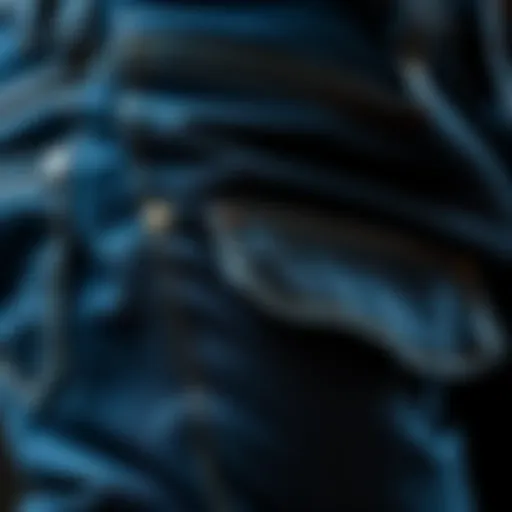Navigating Free Clothing Samples in Fashion Marketing


Intro
In a world obsessed with fast fashion and quick trends, many often overlook the allure of clothing samples. These pieces of fabric heaven, offered for free, can be a gateway to exploring new styles and brands without denting the wallet. It’s like the candy store for adults; the anticipation of uncovering what design or fabric awaits can be thrilling. Not only do free clothing samples serve as a clever marketing tool for brands, but they also weave into the fabric of consumer choices, brand loyalty, and sustainable practices.
This article will peel back the layers of free clothing samples, diving into their origins, the mechanics behind them, and their varying impacts on both consumers and the fashion industry as a whole. The intricate dance of marketing strategies and shopping behaviors will be laid bare, enabling readers to understand the advantages and possible pitfalls for all parties involved. We will also touch on the ethical implications of these initiatives and how they can influence both the environment and consumer identity.
Additionally, practical approaches will be discussed—what steps can be taken to ethically access these samples while keeping an eye on the broader implications within the industry.
As we venture deeper into this fascinating topic, let's start by exploring the fabric knowledge essential for understanding how to appreciate and care for these free treasures.
The Concept of Free Clothing Samples
The world of free clothing samples operates at the intriguing crossroads of consumer demand and brand strategy. As a fascinating concept, free clothing samples serve not just as a promotional tool but also as a reflection of shifting trends within the fashion domain. This practice allows consumers to experience products firsthand without the initial financial commitment, while brands leverage these samples as a means to secure consumer interest and loyalty. The significance of this concept lies in its dual ability to foster brand connection and to meet the tactile needs of consumers who wish to evaluate fit and quality before making a purchase.
Definition and Purpose
To put it simply, free clothing samples refer to garments or accessories provided at no cost, typically to give potential customers an opportunity to try out new designs or items. This practice is often found in various forms, from giveaways at fashion events to online promotions where potential buyers can request samples directly from retailers or brands. The primary purpose of these samples is twofold: they serve as a promotional strategy intended to create awareness about a brand's offerings, while also inviting consumers to engage directly with the product before committing to a purchase.
Not only do sampling strategies aim to boost sales, but they also aim to enhance customer experience. By allowing consumers to physically interact with the clothing, brands can gather valuable insights into customer preferences and perspectives. This creates an environment where feedback loops can flourish, ultimately improving product designs and marketing strategies in the long run.
Historical Context
The roots of the practice extend back several decades, wherein companies recognized the potential of sampling long before the digital age. In the past, free samples primarily showed up at local fairs, in mail orders, or alongside magazine subscriptions. The concept of sending out fabric swatches became a common practice for fabric manufacturers, facilitating a tactile engagement that influenced purchasing behaviors. As industries evolved, so did the methods of distribution.
With the advent of the internet and social media, the landscape of free clothing samples underwent a significant transformation. Brands began to mobilize influencers and a wider audience through online platforms—taking advantage of social networks like Facebook and Instagram to promote their offerings through targeting strategies. This shift marked a new era for free clothing samples, where the process became more immediate and interactive, allowing consumers to share their experiences and thoughts.
This historic trajectory frames the modern understanding of free clothing samples as a critical component in marketing strategies and consumer engagement, revealing a multifaceted exchange of goods that transcends mere transactions. Brands not only gain visibility but also build a community around shared values and aesthetics, laying down the groundwork for lasting customer relationships.
"Sampling is as much about creating connections as it is about selling products; it’s a dialogue between supplier and consumer that continues to evolve."
As we continue exploring this topic, we'll delve deeper into the marketing strategies that fuel this approach, the benefits it brings to both consumers and brands, as well as the ethical considerations that come into play.
Marketing Strategies Involved
The world of free clothing samples operates not just on happenstance; it is embedded in intricate marketing strategies that aim to bridge the chasm between consumer desire and brand identity. Understanding this facet is crucial, as it reveals the motivations behind these offerings and illuminates the benefits for both consumers and brands in the fashion industry.
Sampling as a Marketing Tool
Free clothing samples have become a quintessential marketing tactic for brands, functioning as an effective means to garner attention and drive consumer interaction. By providing potential customers with tangible products, brands tap into a psychological principle known as the reciprocity norm. This principle suggests that when someone receives something for free, they are more likely to feel compelled to return the favor—often by making a purchase or recommending the brand to friends. Here are some detailed mechanisms at play:
- Building Trust: Consumers may be skeptical about new brands or styles. Free samples allow them to test quality without commitment. Enjoying the product can create a ripple effect, fostering a relationship of trust.
- Market Experimentation: Brands can gauge interest in a new clothing line by distributing samples. This feedback loop allows them to adjust their offerings based on real consumer preferences before a wider launch.
- Enhanced Visibility: Sampling campaigns can lead to social media buzz. When consumers showcase their free items, it amplifies brand visibility organically. Questions like "Where did you get that?" can create a chain reaction of interest.
Positioning free samples within a broader marketing strategy is not just advantageous for immediate sales but also for cultivating long-term brand loyalty. Brands like Fashion Nova or Warby Parker utilize this concept effectively, engaging customers in an ongoing dialogue through their free offerings.
Target Audience Identification
To optimize the effectiveness of clothing samples, identifying the right target audience is paramount. Not all demographics will respond similarly to sampling campaigns; thus, brands must strategically select their audience to maximize impact. Here’s how targeted audience identification plays a crucial role:
- Demographic Analysis: Brands often start by analyzing their existing customer base. Identifying age, gender, and shopping habits can help tailor the sampling initiatives. For instance, a niche brand may focus on eco-conscious consumers interested in sustainable materials.
- Psychographic Segmentation: Beyond basic demographics, understanding lifestyle choices and consumer values can refine targeting. Brands focusing on streetwear might sample at music festivals where the lifestyle aligns closely with their offerings.
- Behavioral Insights: Recognizing how customers engage with current trends can guide sample distribution. If there’s a spike in interest around sustainable fashion, brands can direct their samples toward environmentally conscious influencers and communities.
"To be successful, it’s crucial to not just throw samples at everyone and hope for the best; it’s about knowing your audience and speaking their language."
Benefits of Free Clothing Samples
Exploring the idea of free clothing samples reveals a rich tapestry of benefits that impact both consumers and brands in the fashion industry. This section will delve into the distinctive advantages that these samples present, emphasizing how they can create a win-win situation when executed thoughtfully.
For Consumers
Free clothing samples offer consumers an opportunity that goes beyond just acquiring new garments. One of the primary benefits for consumers is the chance to try out products without financial commitment. This is especially valuable in a world flooded with choices.
- Trial without Risk: Trying something new can be daunting, especially when it comes to fashion. Free samples allow consumers to experiment with styles and materials with no strings attached. For instance, a customer uncertain about switching from a polyester blend to organic cotton can get a tactile feel of the difference through a sample.
- Economic Savings: Receiving clothing for free saves money and allows for better budgeting. Given the price tags often associated with fashion trends, these samples can be a literal steal that can alleviate some financial pressure.
- Informed Choices: Many consumers feel overwhelmed by the sheer number of options available. Free samples help remove the guesswork. When a person can physically see and feel a garment, they can ascertain the fit, quality, and style that resonates with them before making a bigger purchase.


"Sampling not only serves as a shopping strategy but also as a bridge to more conscious consumerism, fostering informed choices."
- Personalization: In the end, the sampling process contributes to a sense of individuality. When a consumer tries various samples, it’s an opportunity to discover patterns or styles that align with their personal tastes, which can be a refreshing aspect in a fast-paced retail environment.
For Brands
As much as free clothing samples benefit consumers, brands also find remarkable advantages through this strategy. Sponsoring samples can dramatically boost a brand's visibility and consumer engagement.
- Increased Market Reach: When brands distribute free samples, they cast a wider net, allowing potential customers to experience their products firsthand. This effective marketing tool can reach demographics that may not have considered the brand previously.
- Enhanced Brand Loyalty: Offering free samples cultivates goodwill among consumers, encouraging repeat purchases and loyalty. A positive sample experience creates a lasting impression, leading to long-term customer relationships.
- Feedback and Improvement: Brands can gather invaluable feedback through sampling. By understanding consumer reactions to specific styles or designs, brands can tune their offerings to better meet the marketplace demands and preferences.
- Viral Potential: A well-executed sample campaign can go viral, strengthening a brand's social media presence. When consumers share their experiences with samples on platforms like Instagram or TikTok, it can generate buzz and attract new customers who are curious about the brand.
Potential Drawbacks and Risks
Navigating the landscape of free clothing samples can be a tricky endeavor, embodying various risks and drawbacks that are vital to understand. While the allure of free apparel is tempting for consumers, the downside can also cast a shadow over both individual experiences and brand reputation. Recognizing these potential pitfalls can significantly aid in making informed decisions in this intricate process.
Consumer Misunderstandings
It’s easy for consumers to misconstrue the intentions behind free clothing samples. Many might think that these initiatives are purely altruistic, envisioning brands that genuinely want to gift their products. However, there can be veiled marketing tactics at play. When receiving samples, individuals may feel obligated to promote these items, or they might be swept into unwittingly endorsing products they wouldn’t usually purchase. This misunderstanding can create a false sense of loyalty, leading consumers to mistaken beliefs about how much they like or appreciate a brand.
- Obligation vs. Choice: People often feel they owe something in return when they receive free items, even if it’s not made explicit. This can cloud their judgment and lead to skewed purchasing behaviors.
- Excess in Samples: Another common misconception is the assumption that receiving numerous samples equates to enhanced value. Consumers could end up swamped with items they don’t really need, which may result in waste and dissatisfaction.
Understanding the implications of receiving free clothing samples goes beyond just being excited about new attire. It requires consumers to be aware of the underlying motivations and make independent assessments about the products they engage with.
Brand Image Complications
Brands may also face tricky waters when it comes to offering free clothing samples. For starters, the risk of misrepresentation looms large. If a brand’s samples aren’t up to par with their regular offerings, it can lead to distorted perceptions among potential customers. A poor-quality sample can tarnish the reputation of even the most established fashion labels.
- Quality Assurance: When sending out samples, brands must ensure that these items reflect the true quality associated with their identity. If consumers perceive discrepancies, they might not only choose not to buy but may also share their negative experiences through word-of-mouth or social media platforms like Facebook and Reddit.
- Brand Positioning: In the eyes of the public, free clothing samples might signal that a brand is struggling, creating doubts about sustainability or the authenticity of the brand’s offerings. This perception can dilute a brand's premium positioning or lead consumers to question its longevity.
Ultimately, understanding these potential drawbacks can empower both consumers and brands alike. By staying informed about the risks of misconceptions and brand image complications, they can navigate the world of free clothing samples judiciously, aiming for a more meaningful engagement with fashion.
Ethical Considerations
Ethics in the realm of free clothing samples is a subject that deserves significant attention. In recent years, consumers have become more discerning, not just about the products they purchase, but also about the implications of those products. This section aims to explore the intricate balance between marketing tactics and ethical responsibility in the fashion industry.
Sustainability and Waste Concerns
A pressing ethical issue surrounding free clothing samples is sustainability. The fast fashion sector has often been criticized for its role in environmental degradation. When brands distribute samples, especially in large quantities, there is a potential for waste to increase. After all, not every sample will lead to a sale, and an unwanted sample may end up in the landfill. In recent years, a number of brands have sought to address these concerns by adopting more sustainable practices. For instance, companies like Reformation and Patagonia have integrated eco-friendly materials in their samples, reducing waste while promoting a positive brand image.
Here are some strategies that brands are exploring to tackle sustainability in sampling:
- Eco-friendly Materials: Utilizing organic cotton or recycled fibers for samples.
- Recycling Initiatives: Offering discounts for returning unwanted samples, encouraging a circular economy.
- Minimalist Packaging: Reducing the packaging waste associated with mailing samples.
"Sustainability isn’t just about the product; it's about the entire lifecycle of that product. Brands need to ask themselves: what happens to the samples after they’ve served their purpose?"
By focusing on sustainable practices when distributing samples, brands can align their marketing strategies with consumer values, thus preserving their reputation while still engaging with audiences.
Labor Practices in Sampling
Another layer of ethical considerations pertains to labor practices in the creation and distribution of clothing samples. It's vital for brands to ensure that their production methods, including those related to sample garments, adhere to ethical labor standards. Some brands may cut corners to save costs, leading to exploitative labor conditions, particularly in countries with lax regulations.
Transparency in the supply chain has become a buzzword in the fashion world. Brands that are forthright about where their samples are produced and under what conditions tend to foster trust among their consumer base. Here’s how brands can demonstrate ethical labor practices:
- Certifications: Obtain ethical certifications such as Fair Trade or GOTS (Global Organic Textile Standard).
- Supporting Local Businesses: Partner with local seamstresses and manufacturers, minimizing transportation emissions and supporting local economies.
- Regular Audits: Conduct audits to ensure compliance with labor standards, and publicly share the results to boost transparency.
Ultimately, the ethical approach to sampling reflects the brand's commitment not just to profit, but to social responsibility. In an era where consumers are increasingly interested in the story behind their purchases, ensuring ethical labor practices can have a profound impact on customer loyalty.
By addressing both sustainability and labor concerns, the fashion industry can move towards a more ethical framework in the sourcing and distribution of clothing samples. This transformation is not just beneficial for consumers; it can also elevate brand identity in a competitive marketplace, where ethical considerations sway purchasing decisions.
Consumer Behavior Insights
Understanding consumer behavior in the context of free clothing samples is crucial for both brands and consumers. This section aims to illuminate the intricate dynamics at play when samples influence purchase decisions and foster customer loyalty. These insights stem from the intersection of marketing strategies and consumer psychology, providing an informative look into how sampling impacts the market.


Sampling Influence on Purchase Decisions
The decision-making process of consumers is often influenced by their interactions with clothing samples. When individuals receive a free clothing sample, several psychological mechanisms come into play.
- First Impressions Matter: When a consumer touches and tries on a piece of clothing, they forge a connection with the product. This tangible experience often outweighs marketing messages, creating a stronger likelihood of purchase. A well-made sample that fits well can leave a lasting positive impression, nudging the consumer towards a future buy.
- Complex Decision-Making: Sampling reduces the uncertainties associated with online shopping, a space filled with incongruities between images and reality. When consumers feel unsure about purchasing clothing online, the prospect of trying on a free sample can clarify their decision, pushing them toward a yes or no much faster.
- Sense of Ownership: Gifting a free sample can create a subconscious sense of ownership, where the consumer feels commitment towards the garment. They may reconsider returning it or even opt to purchase additional items from the brand. This tactic is a double-edged sword; while it can increase sales, it could also lead to heightened expectations for quality and style in future products offered by that brand.
Customer Loyalty Development
Building customer loyalty in fashion is akin to weaving a tapestry, where each thread represents an interaction or experience with the brand. Free clothing samples serve as a foundational thread in this intricate design. Here’s how they play a pivotal role in nurturing long-term loyalty:
- Creating Repeat Customers: If a consumer appreciates a sample because of its quality and fit, they are more likely to return for more. Brands that use sampling strategically often observe an uptick in repeat customers. The logic follows that if a customer has had a rewarding experience, they are likely to seek out that brand for future buys.
- Brand Stories Shared: Consumers who receive samples often share their experiences online or with friends, effectively becoming brand ambassadors. This word-of-mouth advertising is invaluable; people trust personal recommendations more than traditional advertising. Each shared experience contributes to an organization's reputation and consumer trust.
- Feedback Loop: Samples allow for immediate consumer feedback. Brands that actively request thoughts on their samples can tailor future offerings based on real input, not just market research. This responsive approach deepens consumer relationships; when customers feel heard, they become loyal advocates for the brand.
Through these insights, it’s clear that sampling plays a dual role—it not only assists in securing immediate purchases but also fosters customer loyalty over the long run. As brands navigate the complex web of consumer behavior, recognizing the significance of free clothing samples can be a game-changer in cultivating lasting connections with their target audience.
"The best marketing doesn't feel like marketing." - Tom Fishburne
As we delve further into this topic, it becomes apparent that the landscape of consumer behavior surrounding free clothing samples cannot be ignored. Brands have an opportunity to not just market but also build relationships—relationships rooted in satisfaction and engagement.
How to Access Free Clothing Samples
In today's fast-paced fashion landscape, the allure of free clothing samples has caught the attention of many fashion enthusiasts and savvy shoppers alike. For consumers, these samples represent an opportunity to engage with brands and try out new products without financial commitment. For brands, enabling access to free samples can foster loyalty and initiate conversations with potential customers. This section sheds light on practical approaches to access these marketing gems while keeping ethical considerations in the forefront.
Online Platforms and Promotions
The internet is a treasure trove for anyone seeking free clothing samples. Various websites and social media platforms host promotions where brands distribute their items as samples. Here’s why this segment is crucial:
- Convenience: Online platforms offer ease of access for individuals looking to score samples. With just a few clicks, interested users can explore numerous offerings from various brands.
- Diverse Options: Whether it be seasonal collections, limited editions, or even clearance items, options are endless. Each platform often promotes numerous brands, catering to different styles and preferences, allowing consumers to find the perfect fit for themselves.
- Time-Sensitive Offers: Promotions can be fleeting. Many companies launch limited-time campaigns where users can sign up or fill out a form to receive samples. Keeping an eye on social media posts or newsletters from favorite brands can turn this into a rewarding endeavor.
Here are some relevant websites and platforms where you can find free clothing samples:
- SampleSource: Known for their consumer sample programs, it often includes beauty and clothing items.
- HouseHoldSamples: They regularly offer clothing samples from emerging and established brands.
- Facebook Groups: Numerous Facebook groups are dedicated to sample lovers. Join these communities to keep abreast of the latest sharing initiatives.
Make sure to follow brands on Instagram and Twitter as they frequently announce giveaways or sampling events suited for their followers.
"Exploring fresh fashion without breaking the bank is an enticing idea! Keep your eyes peeled and your inbox subscribed to catch those giveaways."
Networking with Fashion Brands
Networking with fashion brands is a key avenue for accessing free clothing samples. This approach may require a tad more effort but can pay off substantially, especially for those deeply embedded in the fashion community.
- Build Connections: Attend industry events, trade shows, and fashion expos. These gatherings are hotbeds for networking opportunities. Connect with brand representatives and establish rapport–a friendly chat might lead to opportunities for free samples.
- Leverage Influencer Status: Whether you have thousands of followers or just a handful, blogging or vlogging about fashion can open doors. Brands often provide samples to influencers for exposure. Create content that resonates with a specific niche, and you might be approached by brands seeking exposure.
- Email Campaigns: Don’t hesitate to reach out directly to brands via email. Craft a message that highlights your interest in their products, mentioning how their samples could fit into your styling or review concepts. Tailor each email for personalization.
When reaching out, keep it professional; it’s vital to present yourself as a genuine advocate for the brand rather than just someone after free goods. Remember to be sincere in your requests and follow up politely if necessary.
In summary, accessing free clothing samples is a mix of being savvy and strategic. By utilizing online resources and actively engaging with fashion brands, consumers can enjoy firsthand experience with up-and-coming pieces, all while building lasting relationships in this vibrant industry.
The Role of Social Media
Social media plays a pivotal role in the realm of free clothing samples, creating a dynamic landscape where brands and consumers engage in real-time. The immediacy and wide reach of platforms like Instagram, Facebook, and TikTok have transformed how clothing is marketed, making social media an essential tool for effective brand communication. In a space where trends shift faster than the blink of an eye, harnessing the power of social media can make or break a brand's sampling efforts.
In essence, social media serves as an intermediary, connecting brands with fashion enthusiasts eager for the latest styles and trends. This interaction is beneficial; however, it also comes with a host of considerations. Brands need to identify the right platforms for their target demographics, pinpoint suitable influencer partnerships, and utilize user-generated content effectively, while also maintaining an authentic voice that resonates with these audiences.
Influencer Collaborations
One of the most significant trends within social media is the rise of influencer collaborations. Influencers have become the modern-day gatekeepers of style, wielding immense power to sway consumer opinions and behaviors. Brands often partner with these influencers to maximize their reach and utilize their established credibility. For example, when a well-known fashion influencer shares a post wearing a clothing sample, it not only promotes the brand but also provides potential customers a glimpse into how that item could fit into their own lives.
These collaborations go beyond just product placements. Influencers often craft narratives around their experiences with the clothing samples, which can create an emotional connection between the consumer and the product. If a customer sees an influencer they admire using a clothing item, it sparks intrigue and motivation to try it themselves. This form of marketing can lead to an increased desire for the product and, ultimately, higher conversion rates.
Moreover, collaborations can feel organic if managed correctly. Influencers who are genuinely passionate about a brand tend to resonate better with their followers. This authenticity is crucial since today’s consumers are savvy and can detect insincerity from a mile away.
User-Generated Content


Another vital aspect of social media in this context is the phenomenon of user-generated content (UGC). UGC refers to any content, such as images or videos, created by everyday consumers showcasing their experiences with products. This type of content serves as a testimonial and is often perceived as more trustworthy than traditional advertisements.
Encouraging customers to share their own images or reviews of clothing samples not only enhances a brand’s credibility but also cultivates a sense of community among consumers. When individuals notice marvellous outfits on social media, they feel inspired and empowered to share their own takes on it.
Brands can facilitate this by creating specific hashtags or running contests that encourage users to tag the brand. Engaging with this content by resharing or acknowledging users further strengthens brand loyalty and fosters a sense of belonging.
"Social media is more than a marketing channel; it's a lifeline for brands wanting to connect authentically with their consumers."
For those looking to dive deeper into these subjects, they might explore resources like Wikipedia or check discussions on Reddit.
Future Trends in Clothing Sampling
The landscape of clothing sampling is ever-evolving. As fashion enthusiasts, retailers, and stylists dive into this dynamic space, understanding upcoming trends becomes essential. The future trends in clothing sampling can shape consumer experiences, enhance brand strategies, and push for more sustainable practices. With a world that's increasingly driven by technology and consumer consciousness, future trends paint a vibrant picture of what’s to come.
Augmented Reality in Sampling
Augmented Reality (AR) is making waves in various industries, and fashion is no exception. The introduction of AR in clothing sampling is an exciting development. Imagine being able to try on a dress or a pair of shoes virtually, all from the comfort of your home. This isn't just a gimmick; it's a game changer.
- Enhanced Customer Experience: AR allows users to visualize clothing items, making decision-making more straightforward and less risky. By projecting clothing onto our own images, we can more easily assess comfort, style, and fit without ever stepping foot in a store.
- Reduces Returns: Many retailers face a significant loss due to return rates. By utilizing AR technology, brands can see a reduction in these costs. When customers have a realistic idea of how an item looks on them, they might stick with their choice rather than opting for a return.
- Engagement and Interactivity: The technology fosters a deeper connection between consumers and brands. Engaging experiences lead to increased brand loyalty. Customers share these interactive experiences on social media, indirectly promoting the brand, creating a snowball effect for visibility.
This technological trend signals a future where the in-store experience is blended with a digital savviness that appeals to younger generations, marrying convenience with personalization.
"Augmented Reality is not just about how items look; it's about how they make you feel in the world around you.”
Sustainable Sampling Initiatives
As awareness of environmental issues continues to rise, sustainable fashion practices are moving from being a niche interest to a mainstream expectation. The sampling process is no exception.
- Eco-friendly Materials: Brands are increasingly recognizing the importance of utilizing sustainable fabrics when producing samples. Materials made from recycled plastics or organic cotton not only reduce waste but also resonate with environmentally conscious consumers.
- Minimized Waste: Traditional sampling often leaves behind garments that are immaterial to a brand's final line. Adoption of initiatives focused on circularity—like reusing materials or donating unused samples—plays a critical role in reducing environmental impact.
- Consumer Awareness Campaigns: Brands embracing sustainable sampling are actively educating their audience about their practices. This transparency helps build trust and encourages customers to make responsible shopping choices. They might share the journey of a sample from conception to distribution, creating a narrative that consumers engage with.
In addition, collaborations among fashion companies, nonprofits, and educational institutions emphasize sustainability. The combined effort is essential to shift consumer mindsets towards more eco-friendly options, ensuring that clothing sampling contributes positively to the industry’s ecological footprint.
Together, the advancements in augmented reality and sustainable practices signify profound shifts in the fashion industry. As brands innovate, consumers are poised to experience a new era of clothing sampling that prioritizes technology and sustainability equally. Think of it as moving from just fabric and thread to experiences and ethics.
End and Final Thoughts
As we wrap up this exploration into free clothing samples, it’s clear that this practice embodies a rich tapestry of marketing ingenuity and consumer interaction. The significance of understanding this topic cannot be understated, especially in an era where branding and sustainability are interlinked more than ever.
Balancing Benefits and Ethics
To truly harness the potential of free clothing samples, brands and consumers alike must tread the delicate line between leveraging benefits and adhering to ethical standards. On one side, these samples offer enticing avenues for consumers to engage with brands without the pressure of a financial commitment. From a brand’s perspective, it opens up a path to increase brand visibility and foster customer loyalty. However, the ethical concerns around overproduction and textile waste loom large, leading us to question the long-term impact of such sampling tactics.
The ethical framework surrounding free clothing samples involves considering the sustainability of practices and the implications of consumer behavior. Brands should strive to provide samples that are thoughtfully produced and consider how they fit into the broader environmental picture. This includes reassessing supply chains and minimizing waste.
Key considerations include:
- Offering meaningful samples that align with a brand’s core values
- Ensuring transparency in production processes
- Managing the environmental footprint associated with distribution
Ultimately, the goal should be to create a balance where both the allure of sampling and the responsibility towards ethical practices coexist.
Engagement and Responsibility
Engagement in the context of free clothing samples transcends mere participation. It is fundamentally about fostering a deeper relationship between consumers and brands, while simultaneously respecting the responsibilities that come with such interactions. Consumers have a role to play, not just in choosing what to sample but in how they approach their consumption habits.
Effective engagement happens when brands actively listen to feedback and adapt their offerings accordingly. When customers feel valued, their loyalty increases, which often translates into more sustainable choices. For instance, brands that effectively communicate their sustainable initiatives can establish a loyal customer base that appreciates conscious fashion.
Furthermore, let’s not overlook the importance of social media in bridging this gap. Instagram, TikTok, and other platforms serve as digital avenues for consumers to voice their preferences while amplifying ethical concerns in fashion. This dual role of engagement not only builds brand narratives but also holds companies accountable for their practices and promotes responsible consumerism.
In closing, navigating the terrain of free clothing samples involves a combination of awareness, engagement, and ethical responsibility. The balanced approach is multifaceted, embracing opportunities while carefully weighing the implications of our choices within the fashion ecosystem. Moving forward, both brands and consumers must act as stewards of change, refining practices that pave the way for a more conscientious fashion industry.
"Fashion should be a form of escapism and not a form of imprisonment."
— Alexander McQueen
Whether you’re a stylish shopper or a brand innovator, understanding these dynamics is essential for fostering a future that values not just trends, but also sustainability and ethical practices.
For more on ethical fashion and sustainable practices, check out resources from Sustainable Fashion or learn about the importance of conscious consumerism at The Good Trade.
By keeping these considerations in mind, we can navigate the world of free clothing samples in a way that is both rewarding and responsible.













